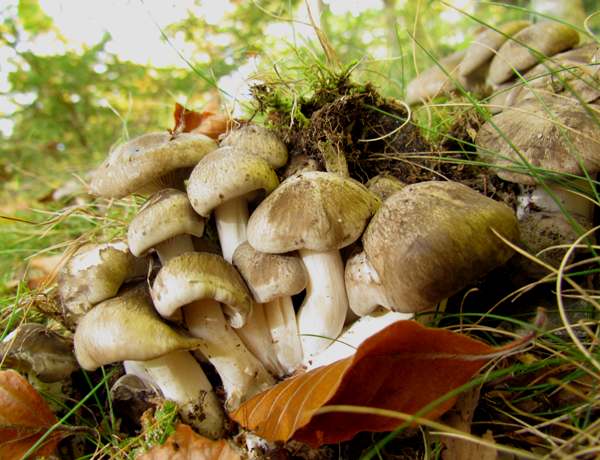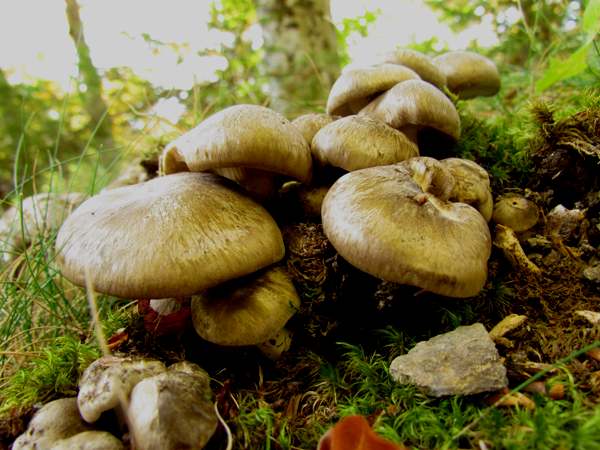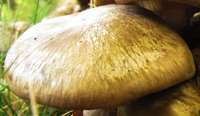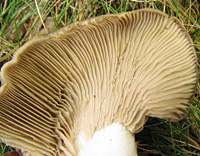Tricholoma sejunctum (Sowerby) Quél. - Deceiving Knight
Phylum: Basidiomycota - Class: Agaricomycetes - Order: Agaricales - Family: Tricholomataceae
Distribution - Taxonomic History - Etymology - Identification - Culinary Notes - Reference Sources

An occasional to rare find, Tricholoma sejunctum, the Deceiving Knight, is a mycorrhizal mushroom of mainly deciduous woodland. Occasionally this species can be seen also under pine trees.
Knights (Tricholoma species) are sometimes difficult to identify with absolute certainty, and what makes this such a tricky (deceptive) mushroom to pin down is the variability of its cap colouring; however, once you have seen several examples there is something distinctive about this substantial and rather attractive mushroom.
Caps of Tricholoma sejunctum are rarely regular, because usually these mushrooms occur in tightly packed clumps or tufts and the caps become distorted as they jostle for space.

Distribution
Being a mycorrhizal mushroom, the fruitbodies recur in the same location year after year; however, in Britain and Ireland there are relatively few such locations - so much so that this species was recorded as 'Vulnerable' on the Red Data List produced by Bruce Ing in 1992. (It does not appear in the list prepared by Shelly Evans et al in 2006.) There are more than 300 formal records of the Deceiving Knight in Britain, most of which are in Scotland and in southern England, an apparent location preference that may simply be due to less monitoring effort in other parts of the country. This species occurs in other parts of mainland Europe and in North America.
Taxonomic history
The basionym of this species dates from 1799, when British mycologist James Sowerby (1757 - 1822) described this species and gave it the binomial name Agaricus sejunctus. (In those early days of fungus taxonomy, most of the gilled mushrooms were included initially in the genus Agaricus!) It was the famous French mycologist Lucien Quélet who, in 1872, transferred this species to the genus Tricholoma, whereupon its scientific name became Tricholoma sejunctum.
Synonyms of Tricholoma sejunctum include Agaricus sejunctus Sowerby, Gyrophila sejuncta (Sowerby) Quél., and Melanoleuca sejuncta (Sowerby) Murrill.
Etymology
Tricholoma was established as a genus by the great Swedish mycologist Elias Magnus Fries. The generic name comes from Greek words meaning 'hairy fringe', and it must be one of the least appropriate mycological genus names, because very few species within this genus have hairy or even shaggily scaly cap margins that would justify the descriptive term.
The specific epithet sejunctum comes from Latin and means 'having separated'; it refers to the almost complete (deeply notched) separation of the gills from the stem.
Identification guide
 |
CapYellowish or greenish, usually somewhat paler towards the margin, with radial brown or grey-brown fibrils; convex, often flattening with a wavy margin and sometimes becoming slightly depressed but with a broad umbo; surface slightly greasy; 4 to 10cm across. The flesh of the cap and of the stem is white and does not change colour on exposure to air. |
 |
GillsWhite at first, turning dirty yellowish-buff as they age; sinuate (notched near the stem). StemWhite, slightly flushed yellow and ; becoming dirty yellow-buff with age; cylindrical; smoothish but with fine longitudinal fibrils; 4 to 8cm long, 1 to 3cm diameter; no stem ring. |
SporesEllipsoidal, smooth, 5-7 x 4-6μm; inamyloid. Spore printWhite. |
|
Odour/taste |
Odour not significant; taste mealy and unpleasant |
Habitat & Ecological role |
Ectomycorrhizal with deciduous broadleaf trees - mainly oaks and birches - but occasionally found also under pines. |
Season |
Late summer and autumn in Britain and Ireland. |
Similar species |
Tricholoma equestre, mainly a northern species in Britain, has a yellow cap with a brown-olive central area, and yellow gills even when young. |
Culinary Notes
Tricholoma sejunctum is recorded as edible in some field guides, but others say that the taste of these mushrooms is nauseating. We therefore do not consider the Deceiving Knight to be a culinary collectible.
Reference Sources
Fascinated by Fungi, 2nd Edition, Pat O'Reilly 2016, reprinted by Coch-y-bonddu Books in 2022.
Kibby, G (2013) The Genus Tricholoma in Britain, published by Geoffrey Kibby
Funga Nordica: 2nd edition 2012. Edited by Knudsen, H. & Vesterholt, J. ISBN 9788798396130
Dictionary of the Fungi; Paul M. Kirk, Paul F. Cannon, David W. Minter and J. A. Stalpers; CABI, 2008
Taxonomic history and synonym information on these pages is drawn from many sources but in particular from the British Mycological Society's GB Checklist of Fungi.
Fascinated by Fungi. Back by popular demand, Pat O'Reilly's best-selling 450-page hardback book is available now. The latest second edition was republished with a sparkling new cover design in September 2022 by Coch-y-Bonddu Books. Full details and copies are available from the publisher's online bookshop...

